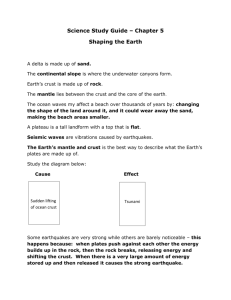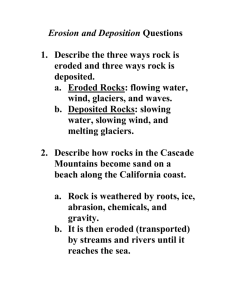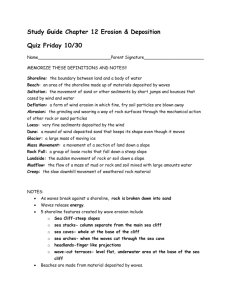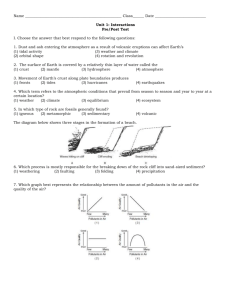WED - Yantis Pride
advertisement
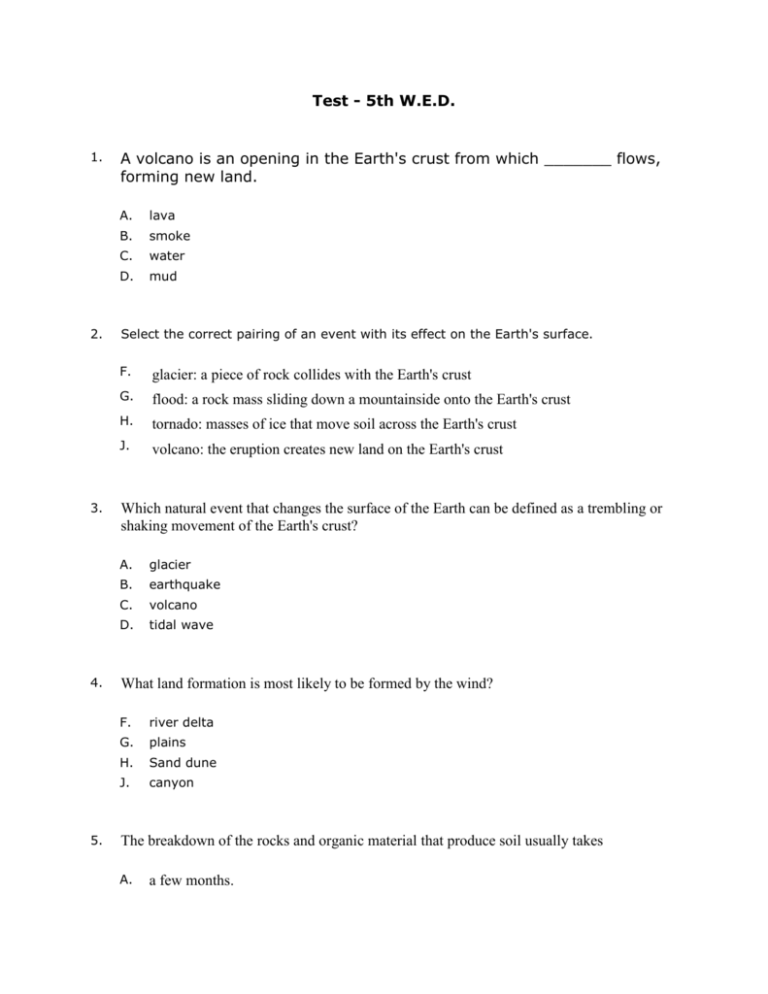
Test - 5th W.E.D. 1. 2. 3. 4. 5. A volcano is an opening in the Earth's crust from which _______ flows, forming new land. A. lava B. smoke C. water D. mud Select the correct pairing of an event with its effect on the Earth's surface. F. glacier: a piece of rock collides with the Earth's crust G. flood: a rock mass sliding down a mountainside onto the Earth's crust H. tornado: masses of ice that move soil across the Earth's crust J. volcano: the eruption creates new land on the Earth's crust Which natural event that changes the surface of the Earth can be defined as a trembling or shaking movement of the Earth's crust? A. glacier B. earthquake C. volcano D. tidal wave What land formation is most likely to be formed by the wind? F. river delta G. plains H. Sand dune J. canyon The breakdown of the rocks and organic material that produce soil usually takes A. a few months. 6. 7. 8. 9. B. thousands of years C. two weeks D. up to five years What would be the main cause of weathering on a beach? F. the people walking on the beach G. the movement of the waves H. the pet dogs running on the sand J. the sunshine heating the sand An earthquake most likely changes which part of the earth? A. The air. B. The weather. C. The land. D. The oceans. In which of these ways can volcanoes help build up new land? F. By adding heat to Earth’s surface G. By adding gases to the atmosphere H. By adding lava to Earth’s surface J. By adding water vapor to the atmosphere Which of these can cause sharp, rough mountains to become rounded and smooth over time? A. Wind and rain B. The sun’s rays C. Light and darkness D. Earth’s magnetic field 10. Canyons on Mars look similar to canyons on the Earth. This similarity may indicate that Mars once had - F. high winds G. rivers H. large floods J. glaciers 11. Earthquakes are caused by the A. movement of the Earth's jet stream. B. Moon's revolution. C. Earth's rotation. D. movement in the Earth's crust. 12. Erosion most likely causes the F. development of crystals. G. carrying away of sediment. H. cementation of rock fragments. J. breakdown of living materials. 13. The Davis Mountains in West Texas used to be taller than they are now. Which of the following conditions most likely caused the mountains to become shorter over time? A. Heat and pressure B. Soil deposition C. Rain and wind D. River formation 14. What can a glacier do to Earth's surface? F. Create fossils G. Scrape the land H. Cause lava flows 15 Look at the diagram of land features below. The river delta is an area where sediments . from water runoff are deposited. The sediments in this river delta most likely come from the — A. mountain range B. desert C. ocean floor 16. Which item is not a weathering process that can cause landforms to form and change? F. water waves G. snow H. wind J. ice 17. Which list describes landforms that can be formed by weathering processes such as wind, water, and ice? A. delta, canyon, and sand dune B. pond, river, and lake C. beach, mountain, and forest D. river, canyon, and forest 18. Galye and Kendle were creating a poster to display in their science class about glaciers. They had researched glaciers and came up with a list of facts. Which fact below is incorrect? F. Glaciers were responsible for creating the Great Lakes. G. Glaciers float on top of salt water. H. Moving glaciers create valleys. J. Glaciers are composed of frozen freshwater. 19. White Sands, New Mexico, is a popular tourist attraction. People often say that it is an interesting place to visit because the landscape is different every year. What causes the landscape to be constantly changing? A. The sun changes the color of the sand throughout the year. B. New species of plants are being introduced to the area by tourists. C. The shape and size of the sand dunes are changed by the action of the wind. D. The chemical reaction between the acid rain and the sand changes the texture of the sand. 20. The picture shows a river delta where the river is flowing into the ocean. How do river deltas change over time? F. G. More and more sediments build up around the delta. The river develops more branches. Water erosion continues. The ocean wears away the land, and the coastline recedes. H. J. Water erosion continues. Smaller river branches disappear, and the main branch becomes deeper. Fewer sediments are deposited into the river system. The river valley dries up, and vegetation dies out. 21. The movement of water changes land. Which illustration BEST shows when a river began creating a canyon? A. B. C. D. 22. Coastlines are constantly changing appearance due to the waves. Which of the following is an example of how water weathers a coastline? F. The waves move sand on the beach. G. The waves move sand off the beach. H. The waves hit the cliff and break off pieces. J. The waves bring salt water into a bay area. 23 . Landforms are evidence that constructive and destructive forces cause change to the surface of the earth. Which of the following statements best describes the formation of the landform in the picture above? A. B. Sand is blown around and then builds up in a certain area. Glacier movement removed the layers of sediment. C. D. An earthquake caused the rock layers to break away. Wind and water weathered and eroded the rock. 24. Glaciers are masses of ice that move slowly on land. Which of these features was most likely formed by a glacier? F. A wide valley G. A deep ocean H. A lava flow J. A mountain range 25. Before a field trip to a cave, a science class studied this picture. Which two features of this cave system were most likely formed by the slow buildup of minerals from water drops? A. Pool of water and trench B. Pool of water and stalagmite C. Stalactite and trench D. Stalagmite and stalactite 26. Which diagram MOST LIKELY shows a change in the Earth's surface caused by hot, molten rock? F. I G. II H. III J. IV 27. Which diagram MOST LIKELY shows a change in the Earth's surface caused by an earthquake? A. I B. II C. III D. IV 28. Which diagram MOST LIKELY shows a change in the Earth's surface caused by heavy rain? F. I G. II H. III J. IV 29. The picture below is of an arch, a geological feature that forms in some deserts. How did this arch most likely get its shape? A. Animals slowly removed the pieces of the rock that were once around the arch. B. The arch originally formed that way. C. Plant roots grew into the original rock, breaking it apart and leaving the arch behind. D. Wind and water removed the rock that was originally around and under the arch. 30. A natural event made the changes in the Earth's surface that caused the road shown in the picture to crack and break. Which kind of event was it? 31. F. wind G. flood H. earthquake J. snowstorm Freezing water can make cracks form in rocks. The picture shows a large rock with cracks in it. Over time, more cracks will form. The rock will break into very small pieces. What will these pieces turn into? A. plants B. soil C. water D. wood 32. The picture below shows tree roots growing into and around several large rocks. The tree roots are most likely F. G. H. J. causing the rocks to come together to form larger rocks. breaking the rocks into smaller pieces. providing the rocks with heat energy the rocks need to live. changing sedimentary rocks into metamorphic rocks.
